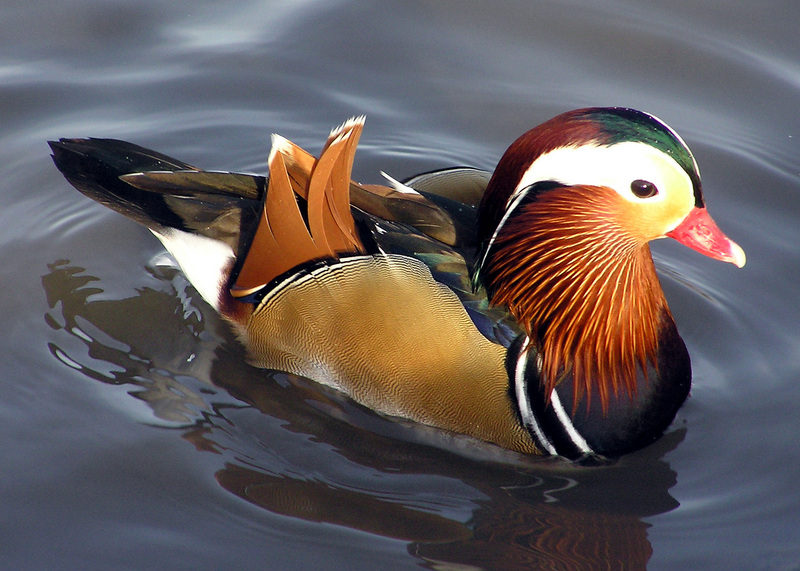|
| Query: great white | Result: 218th of 747 | |
Mandarin Duck (Aix galericulata) - Wiki
| Subject: | Mandarin Duck (Aix galericulata) - Wiki
| |

| Resolution: 1770x1264
File Size: 694406 Bytes
Date: 2005:01:13 12:20:03
Camera: C750UZ (OLYMPUS CORPORATION)
F number: f/3.7
Exposure: 10/2500 sec
Focal Length: 630/10
Upload Date: 2007:08:31 01:08:06
|
Mandarin Duck
From Wikipedia, the free encyclopedia
[Photo] Mandarin Duck in an English zoo. English: Mandarin Duck at Slimbridge Wildfowl and Wetlands Centre, Gloucestershire, England. Fran??ais : Canard mandarin (Aix galericulata). R??serve ornithologique de Slimbridge, dans le Gloucestershire (Angleterre). Photographed by Adrian Pingstone in January 2005
The Mandarin Duck (Aix galericulata), or just Mandarin, is a medium-sized perching duck, closely related to the North American Wood Duck. It is 41-49 cm long with a 65-75 cm wingspan.
The adult male is a striking and unmistakable bird. It has a red bill, large white crescent above the eye and reddish face and "whiskers". The breast is purple with two vertical white bars, and the flanks ruddy, with two orange "sails" at the back. The female is similar to female Wood Duck, with a white eye-ring and stripe running back from the eye, but is paler below, has a small white flank stripe, and a pale tip to its bill.
Mandarin Ducks, which are referred to by the Chinese as Yuan-yang (Simplified Chinese: ??????; Traditional Chinese: 鴛鴦; Pinyin: yu??n y??ng), are frequently featured in Oriental art and are regarded as a symbol of conjugal affection and fidelity.
A Chinese proverb for loving couples uses the Mandarin Duck as a metaphor: "Two mandarin ducks playing in water" (Simplified Chinese: ?????????水; Traditional Chinese: 鴛鴦???水; Pinyin: yu??n y??ng x?? sh??i). The Mandarin Duck symbol is also used in Chinese weddings, because in traditional Chinese lore they symbolize wedded bliss and fidelity. In reality, though, the ducks find new partners each year.
The species was once widespread in eastern Asia, but it is now endangered despite being evaluated as Least Concern because of large-scale exports and the destruction of its forest habitat. The populations in eastern Russia and in China are both probably well below 1,000 pairs, although Japan may have around 5,000 pairs.
Specimens frequently escape from collections, and in the 20th century a feral population numbering about 1,000 pairs was established in Great Britain. Although this is of great conservational significance, the birds are not protected in the UK since the species is not native there.
In the wild, Mandarin Ducks breed in densely wooded areas near shallow lakes, marshes or ponds. They nest in cavities in trees close to water. Shortly after the ducklings hatch, their mother flies to the ground and coaxes the ducklings to leap from the nest. The Asian populations are migrary, overwintering in lowland eastern China and southern Japan.
Mandarins feed by dabbling or walking on land. They mainly eat plants and seeds, especially beechmast. They feed mainly near dawn or dusk, perching in trees or on the ground during the day.
Mandarins may form small flocks in winter, but rarely associate with other ducks.
Domestication
The Mandarin was known and revered in Asia well before the common era. Westerners were quick to discover them when they began to visit that area of the world -- captive Mandarins were brought to Europe as early as the 1700’s. The Mandarin is easy to care for and breed and is therefore commonly kept by private breeders, on game farms and in zoos.
http://en.wikipedia.org/wiki/Mandarin_Duck
| The text in this page is based on the copyrighted Wikipedia article shown in above URL. It is used under the GNU Free Documentation License. You may redistribute it, verbatim or modified, providing that you comply with the terms of the GFDL. |
|
Comments |
|---|
| | Guest |
|
Scientific Name: Aix galericulata (Linnaeus, 1758)
Common Names: Mandarin Duck, Mandarin
French: Canard mandarin; German: Mandarinente; Spanish: Pato mandarín
Taxonomy: Anas galericulata Linnaeus, 1758, China. |
^o^
Animal Pictures Archive for smart phones
^o^
|
|
|

